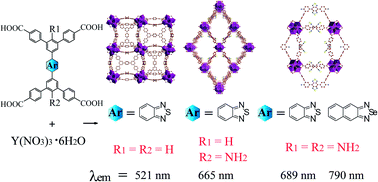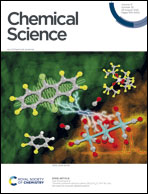Amino group induced structural diversity and near-infrared emission of yttrium-tetracarboxylate frameworks†
Abstract
Near-infrared (NIR)-emitting materials have been extensively studied due to their important applications in biosensing and bioimaging. Luminescent metal–organic frameworks (LMOFs) are a new class of highly emissive materials with strong potential for utilization in biomedical related fields because of their nearly unlimited structural and compositional tunability. However, very little work has been reported on organic linker-based NIR-MOFs and their emission properties. In the present work, a series of yttrium-tetracarboxylate-based LMOFs (HIAM-390X) are prepared via judicious linker design to achieve NIR emission with diverse structures. The introduction of an amino group not only offers the remarkable emission bathochromic shift from 521 nm, 665 nm to 689 nm for the resultant MOFs, but also influences the linker conformations, leading to the topology evolution from (4,12)-c ftw, (4,8)-c scu, which is rarely reported in rare earth element-based MOFs, to an unprecedented topology hlx for HIAM-3901 (without an amino group), HIAM-3905 (with one amino group) and HIAM-3906 (with two amino groups). Among these MOFs, HIAM-3907 shows an emission maximum at ∼790 nm, with the emission tail close to 1000 nm. The NIR emission may be attributed to the combination of the strongly electron-donating amino group and the strongly electron-withdrawing acceptor naphtho[2,3-c][1,2,5]selenadiazole. This work sheds light on the rational design of organic linker-based LMOFs with controlled structures and NIR emission, and inspires future interest in biosensing and bioimaging related applications of NIR-MOFs.



 Please wait while we load your content...
Please wait while we load your content...